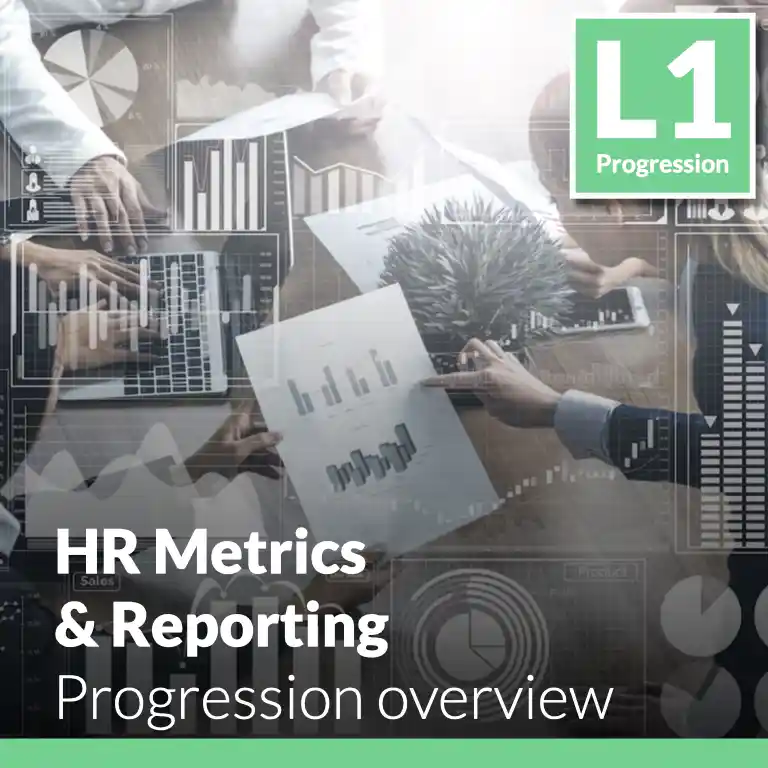Enjoy instant access to a scalable system of proven practices and execution-ready tools. Built to launch strategic HR programs 5X faster!
✓ Enjoy platform access
✓ Create your HR roadmap
✓ View open content in library
✓ Access dozens of practices:
⤷ The HR Strategy program
⤷ Explainers and deep dives
⤷ Supplemental guides
⤷ Insight articles
⤷ Weekly best practices
⤷ And more!
100% Free. No credit card required.
This guide is part of a progression set comprised of Core, Advanced, and Emerging HR Metrics & Reporting practices.
The structured measurement and presentation of employee and human resources process data provide quantitative insights to drive objective and educated decision-making by HR and functional managers. It creates standards and foundations for a repeatable and reliable reporting infrastructure that supports basic HR data analysis and communications.
As with other corporate functions, HR and Talent processes generate a wealth of information that can be used to evaluate the efficiency, effectiveness, and impact of various strategies and programs. This data is analyzed to monitor and improve the effect of HR processes, practices, policies, or programs on human capabilities in the workplace. The practices at this level create a foundation for reliable reporting that can be leveraged to support basic decision-making across the organization. It establishes trust in HR reports by standardizing and structuring the core data entered into various HR systems. They inspire confidence with their direct linkage to specified business objectives and initiatives in a way that demonstrates HR’s contributions to the achievement of those.
HR Metrics & Reporting differs from "Workforce Analytics" in several ways. It covers the most basic types of data analysis and analytic techniques, and it relates to the primarily descriptive and relative analyses, using basic volume, time, and cost metrics with some fundamental ratios such as cost per hire or (average) time to fill. Workforce Analytics, on the other hand, 1) leverages more complex or indexed HR data (e.g., top performing senior systems engineers in the UK), 2) is often combined with business data (e.g., sales performance), 3) uses more advanced statistical techniques (e.g., from correlations to predictive analyses to AI-generated insights), and 4) targets insights to business leaders rather than primarily HR managers and their leaders.
The data generated while conducting HR's base operations - running processes, practices, policies, and programs - should be used to indicate the health of each of those and the extent to which they achieve their designed purpose. Such information creates a basis for observations regarding those operations' efficiency, effectiveness, and impact. The consistency and reliability of that data are essential to gaining the credibility and confidence of leaders and functional managers as providers of useful insights into their operations and employees. The creation and documentation of standard methods of calculation and reporting create a shared awareness of the focus on best practices that are widely accepted and utilized across functions, particularly those with high credibility for accurate and timely reporting (e.g., Finance, Sales, etc.).
These basic insights enable management to monitor and improve the performance of processes such as cost per hire, workforce health indicators, including turnover, and the impact of critical employee programs, such as the quality of new hires. Engaging analytic experts in other, more established functions bolsters the confidence that the broader organization has in HR’s reporting capabilities and outputs and helps the HR team build its skills and capabilities to produce more valuable reporting and insights over time. A robust HR Metrics and Reporting capability is considered critical to the evolution and contribution of the HR function to the business. It establishes the function as one reliant upon more objective views and insights into talent-based trends and contributions. This helps create an impression of HR as a provider of valid and demonstrable data on the efficiency and effectiveness of its range of processes, practices, and programs.
Adopting these practices creates a structured foundation for growth and increasing sophistication in producing solid and useful insights into the value and effectiveness of HR practices, programs, and processes. It establishes HR as a business-aligned function that is focused on the impact that it has on key elements of operational strategies. HR measures are derived directly from business objectives and the associated HR outcomes that will define the function’s level of impact on those business objectives. It provides detailed clarity on the nature and location of every available piece of HR and talent data that is collected or computed by way of ensuring that the data is entered into the relevant systems and subsequently used consistently. These practices define a consistent method for analyzing and reporting occurrences or trends for each reporting element, ensuring consistency and reliability in data and analyses across report creators and users. It also establishes formal relationships with data, analytics, and technology experts in other functions that help fill capability gaps in HR while producing more powerful and useful insights into the critical trends in people management.
Aligning metrics to key organizational strategies and tactics is essential for creating and developing quality metrics relevant to the business's needs.
Identifying the specific location of data in databases and documenting the calculation methods that will be used to ensure reliability and consistency across time and reports.
Enabling uniform reporting with consistent timeframes, calculations, and analysis levels tailored to decision-making needs.
Partnering with other functions where data analytics expertise is more common is a cost-effective way for HR to develop the necessary analyses and reports.

Enjoy instant access to a scalable system of proven practices and execution-ready tools. Built to launch strategic HR programs 5X faster!